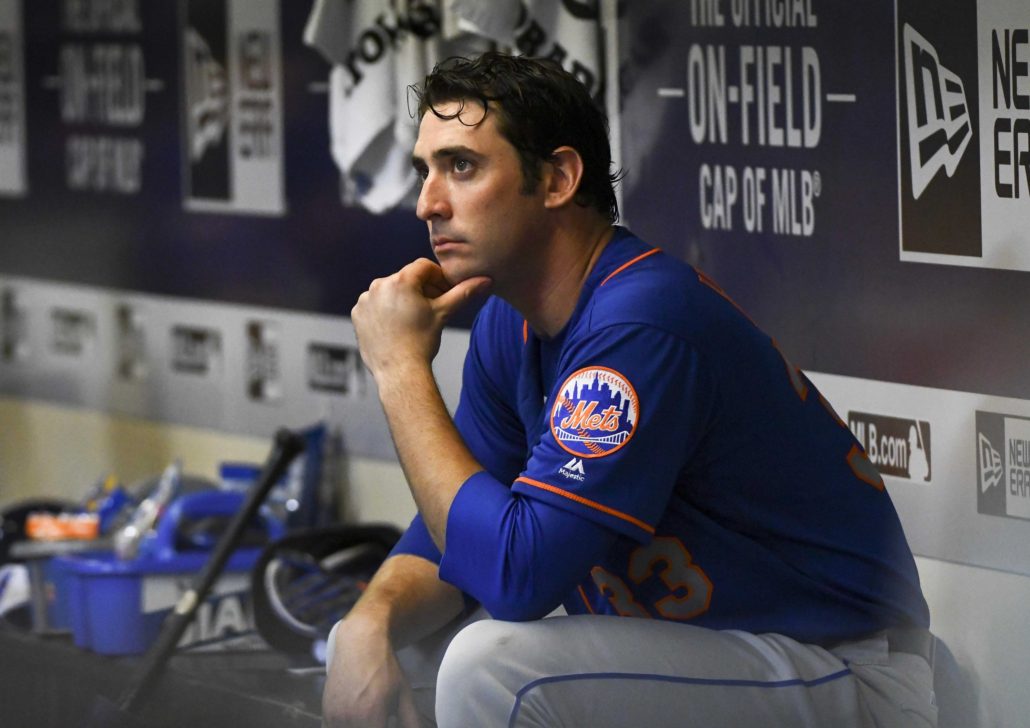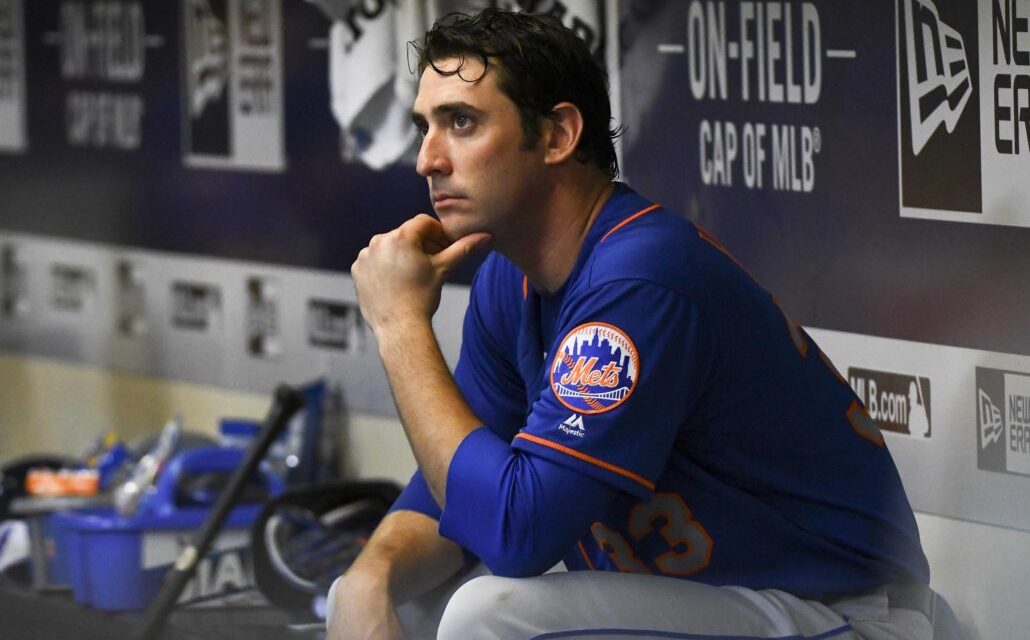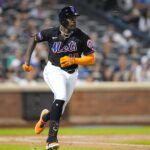
This wasn’t supposed to be how Matt Harvey made his return to the mound Friday night in Milwaukee. The one-time ace of the New York Mets staff is quickly losing the flare and response his starts once had on fans; with hashtags celebrating Harvey Day on Twitter, fans donning Batman cowls in the stands, and the right-hander from Connecticut dazzling every fifth day on the mound.
No, these days the man once dubbed “The Dark Knight” is looking more like Harvey Two-Face, still offering glimmers of hope that he still has the intensity and ace-like stuff in his arsenal, while also showcasing his ‘dark’ side with diminishing velocity and strikeouts-per-nine numbers, a high WHIP and inflated walk stats, along with loss of command and location.
Not only are Harvey’s stat lines troubling, but, add in the mess Harvey made for himself by failing to show up for last Saturday’s game, resulting in a three-game suspension for his actions. Harvey had to repent on Tuesday, apologizing to teammates and coaches in the clubhouse before making a public mea culpa to the media and the fans.
“I made a mistake,” Harvey said. “I am doing everything I can to make sure it doesn’t happen again.”
A good first step to help righting that ship was to come out on Friday and perform, period. After the Mets decided that it was best for Harvey to make his return to the mound away from Citi Field and the potential jeering from the home crowd, they penciled him in for his second start of his career in Milwaukee. His lone start prior to last night’s loss was back on June 10, 2016, when Harvey fired six innings of one-run ball, allowing just two hits with two walks and eight strikeouts on 97 pitches. Boy, how fans would sign up for a start like that again!
Alas, 2016 feels like a decade ago now with the Harvey that’s been on display. In last night’s loss, Harvey lasted just five-innings, on the same day the club announced closer Jeurys Familia underwent an operation to remove a blood clot near his right shoulder, potentially losing their closer for the remainder of the year. The Mets needed some length from Harvey, and he failed to deliver.
Pitching into the sixth, and now with the score tied thanks to Neil Walker’s RBI single in the top half of the inning, Harvey failed to put away the bottom of the Brewers’ lineup. A single by Keon Broxton followed by a home run to Eric Sogard put the Brewers ahead by two. The Brewers sent Orlando Arcia to pinch-hit for Matt Garza, who promptly smacked Harvey’s four-seam fastball into the right-centerfield stands, giving the Brewers a 5-2 lead that they wouldn’t cede.
And just like that, Harvey’s night was finished. Another ugly stat line: 5 innings, 7 hits, 5 runs (all earned), 5 walks, 3 home runs, and 6 strikeouts on 106 pitches. Just 59 of those pitches for strikes, a 56% strike rate, his worst of the season.
These are troubling times for the 28-year-old to endure. We know Harvey is a competitor, and has never shied away from wanting to be labeled as one of the best pitchers in the sport. It’s also reasonable to expect that Harvey might never be the same pitcher that took the league by storm from his debut back in 2012. Two surgeries (Tommy John and thoracic outlet syndrome) is a lot to come back from, especially considering that baseball doesn’t have much of a track record when it comes to pitchers coming back from TOS.

There are some signs to point to why Harvey is having such a difficult time out on the mound. His aforementioned strikeout-per-nine numbers are way down from career norms, currently at 5.85 (89th as of Sunday night among qualified starters in baseball), and his walks-per-nine are way up at 4.05. Harvey has walked at least two batters in each of his last five starts; compare that to his 2015 season where he had 20 starts of one walk or less.
Another less talked about stat but one that’s gaining mainstream attention is Harvey’s average spin rate on his four-seam fastball. Of the 237 four-seam fastballs Harvey has thrown, the average rpm on those pitches is 2098, which is below the major league average of 2182 rpm. What does that all mean about Harvey’s fastball? According to Keith Law in his new advanced statistics book, Smart Baseball, spin rate on four-seam fastballs “can compensate for lower velocity, while higher-velocity fastballs without spin tend to be less effective than those with more spin and a few mph less of velocity.”
Law cites injured Yankees’ starter Nathan Eovaldi as prime example of a guy who throws hard, yet doesn’t miss many bats. Law writes how Eovadli had an average four-seam fastball velocity of 97.1 mph in 2016, prior to his torn UCL in his right elbow. However, Law cites that more than half of his fastballs came in with spin rates under 2300 rpm (league average was roughly 2226 in 2016), which means that even though his pitches were coming to the plate quickly, his fastballs were spinning at a slower rate and with less movement on them. Essentially, Eovaldi was tossing flat fastballs.
And this is not the first time writers are mentioning Harvey’s declining spin rate. Anthony DiComo of MLB.com wrote about Harvey’s declining velocity and spin rate back in 2015, when DiComo noticed Harvey’s numbers were trending downward in the July and August months of the season. This paragraph in DiComo’s article sums up what spin rate aids in doing for pitchers:
“Former Major League pitcher Zach Day, who works at TrackMan, a pitch-tracking system employed by both the Mets and Statcast™, noted that spin rate correlates quite closely with swing-and-miss rate. That, in turn, is an excellent indicator of success — one way to quantify what pitchers refer to as “stuff,” or as Day puts it, “your life on your fastball.” So it is worth noting that as Harvey’s velocity and spin rate have fallen, particularly in comparison to the game’s other elite starters, his strikeouts have fallen in kind — from 8.81 before the All-Star break to 6.75 after it.”
If you look at Fangraphs’ Pitch Values chart on Harvey, you’ll also notice that his wFB (fastball runs above average) is -7.7 after Friday night’s loss, which is currently 92nd in baseball among qualified starters, worse than C.C. Sabathia, Bartolo Colon, and R.A. Dickey, pitchers not noted for their fastballs. It’s not a coincidence that Harvey’s SwStr% (swinging strike percentage) is at its lowest for his career, at 7.9 percent, good for 78th in baseball.
These are tough times for Harvey, and it’s hard to watch considering what he has done in the past and what he has meant for this organization. Harvey even noted during spring training when scouts and fans alike were talking about his lowered velocity that he needed to do more with less, telling James Wagner of the New York Times, “With this, I’m not looking to throw 100 miles per hour again or 97 even. My job is to get people out no matter what I’m throwing.”
It’s easier to get away with mistakes when you’re throwing free and easy in the upper nineties. However, Harvey could take a lesson from pitchers of the past who after losing a few miles-per-hour on their fastballs learned to locate and command their fastballs, and have strong secondary stuff.
Though the light might be dimming some, the Bat Signal is still lit in the Manhattan sky, as Met fans are still anxiously awaiting The Dark Knight to hopefully return to form.















